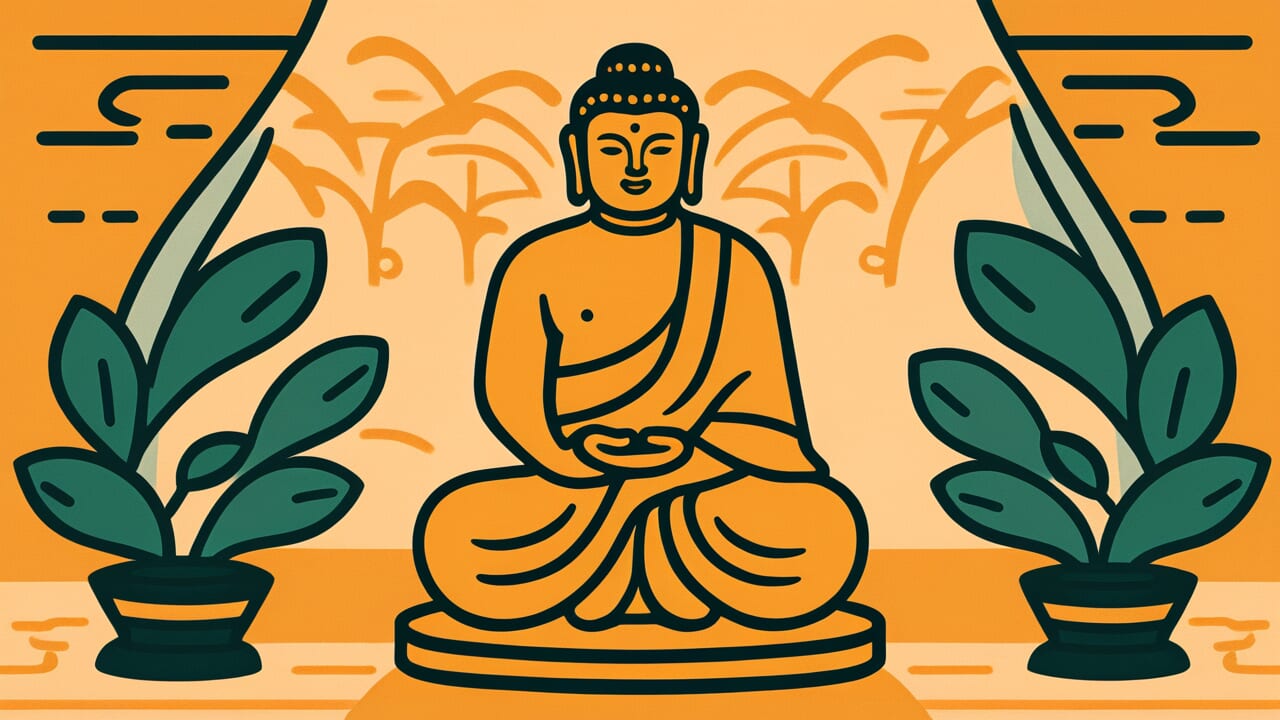How to Read “A standing Buddha uses a sitting Buddha”
たちぼとけがいぼとけをつかう
Meaning of “A standing Buddha uses a sitting Buddha”
“A standing Buddha uses a sitting Buddha” means someone in a lower position uses or manipulates someone in a higher position for their own purposes.
A sitting Buddha statue symbolizes a stable, established position. A standing Buddha represents a lower-ranking figure who moves around.
In the proper order, the sitting Buddha should be superior. But this proverb describes a reversed situation where the standing Buddha uses the sitting one.
This saying applies to organizations and relationships where the hierarchy is flipped from what it should be. For example, when a subordinate cleverly manipulates their boss, or when a junior controls a senior.
The proverb isn’t just describing facts. It carries criticism or irony about disrupted order.
The proverb’s strength lies in using familiar Buddha imagery to clearly express this unnatural reversal of hierarchy.
Origin and Etymology
No clear written records explain this proverb’s origin. However, the word structure offers interesting insights.
The contrast between “standing Buddha” and “sitting Buddha” forms the core of this saying. Buddha statues come in standing and sitting forms.
Standing statues show active postures. Sitting statues show stable postures. In Buddhist art, standing figures often represent active scenes like welcoming souls or preaching.
Sitting figures usually represent meditation or enlightenment.
This proverb shows a reversal. The “sitting Buddha” with its stable position should rank higher. Yet the moving “standing Buddha” commands it.
Using sacred Buddha statues as metaphors adds ironic weight to this reversed hierarchy.
During the Edo period, society had strict class systems. Yet people in lower positions sometimes moved those above them through wit and action.
This proverb likely emerged to express that reality. It uses Buddha statues, familiar to everyone, to cleverly point out the gap between formal order and actual power.
The saying reflects common people’s wisdom in humorously noting this disconnect.
Usage Examples
- That new employee talked the department head into approving his project. It’s truly a standing Buddha using a sitting Buddha.
- That young worker moves the seniors around like a standing Buddha uses a sitting Buddha. I wonder how long that will work.
Universal Wisdom
“A standing Buddha uses a sitting Buddha” captures a timeless phenomenon. It shows the gap between formal hierarchy and actual power in human society.
Why does this reversal happen? Because formal authority like titles and positions doesn’t always match the power to actually move things.
People in higher positions aren’t always competent or action-oriented. Sometimes their position makes them slow to act.
Meanwhile, those in lower positions stay nimble. They end up controlling situations through their agility.
This proverb has endured because it reflects deep insight into human nature. Everyone tries to maximize their position and abilities to survive.
Those in lower positions can’t confront directly. So they use wisdom and quick thinking instead.
Those in higher positions sometimes grow complacent. They let their guard down because of their secure status.
This power reversal isn’t new. It has repeated throughout history in organizations and relationships everywhere.
Our ancestors recognized this subtle aspect of human society. They expressed it using the familiar metaphor of Buddha statues.
The proverb sharply points out a fundamental contradiction in human society. The gap between form and substance, between appearance and reality.
When AI Hears This
In physics, energy naturally flows from high places to low places. Water falls from high ground to low ground.
Heat moves from hot objects to cold ones. What matters here is that the side with energy can make other objects work without moving itself.
The relationship between standing and sitting Buddha statues follows this same physical law. Standing position has higher potential energy than sitting.
The energetically advantaged position naturally moves the disadvantaged one. What’s interesting is that the standing Buddha itself doesn’t move.
In physics, an energy source doesn’t need to move itself. Like a power plant sending electricity without moving, the commanding side can exert influence while staying still.
The second law of thermodynamics says energy transfer always loses some usable form. Applied to human society, this matches how efficiency drops as commands travel down.
When upper management’s intentions reach the ground level, information always degrades or gets misunderstood. This is unavoidable, just like physical laws.
This proverb suggests that social hierarchy isn’t just cultural. It operates on the same principles as the physical laws governing the universe.
Lessons for Today
This proverb teaches modern people to look beyond formal positions. We need eyes that can see actual relationships and real power dynamics.
If you’re in a higher position, don’t rest on your status. You must maintain the power to actually move things.
Titles alone won’t move people. Only by maintaining trust and real ability can you truly lead.
If you feel you’re in a lower position now, don’t despair. With wisdom and action, you can have influence beyond your rank.
However, use that power to improve the whole organization, not to manipulate others.
What matters most is healthy balance. Hierarchies are necessary structures that make society function.
But when they become rigid and divorced from reality, organizations lose vitality. We need flexibility to fairly evaluate real contributions and abilities while respecting formal structures.
That balance may be the challenge this proverb poses to us today.



Comments